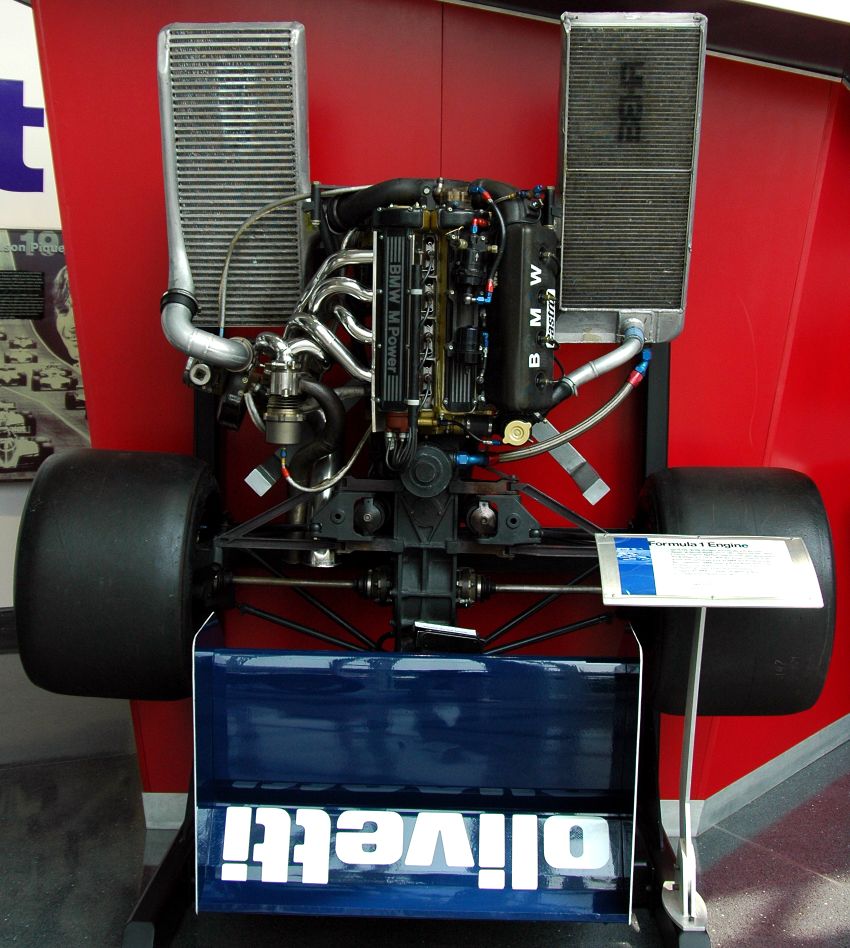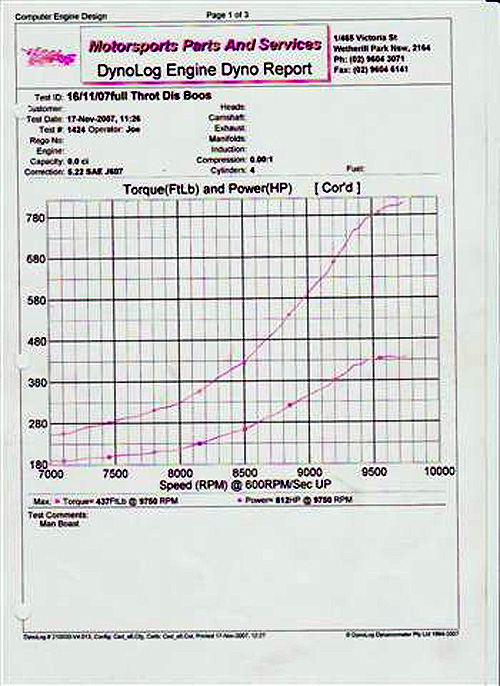Are there any engines out there that make peak torque and power at the same engine speed?
The only reason behind this question is that this discussion came up at work developing rating curves, and the general feeling in the room is that it would feel somewhat strange, but no one had a good reason why it shouldn't be done. This was in the realm of diesel engines and off highway equipment, but I'm curious what the hive thinks, even if it pertains to on-road gasoline applications.
The math would make it tough- the drop off in torque from peak power would be VERY dramatic for the power to go down at the same engine speed. Possible- but it would be more like one would have to bail on boost to make it happen.
If you take a gasoline engine and impose a rev limiter that's below the torque peak, then peak power and torque are both going to occur at the imposed limiter. Also, electric motors are pretty close to being constant power, so peak torque and peak power will both happen just above 0 RPM.
Neither of those is really what you're asking, and I agree with alfadriver, you won't see it in a real-world gasoline engine because it's a stupid way to design an engine. :)
So it might be something that would only happen in a diesel then, where the power curve above torque peak is controlled more by fueling than by actual mechanical characteristics of the engine. The reason this even comes up is because of the relationship between power levels and emissions requirement breakpoints, but we still want as much low end torque as possible.
In reply to gearheadE30:
When you put electronic limits on anything- things can happen.
But it's highly unlikely that anyone would limit the engine just at peak power or peak torque- there will be room above both.
In a gasoline engine, yes. In a diesel engine, they're limited across the board. With electronic control, you literally get to pick whatever torque curve you want within mechanical limits of the system. Unfortunately, emissions regulations usually (always) trump the mechanical limits, from what I've seen.
Okay, so from a mechanical/physics standpoint, and due to a different method of controlling emissions, it sounds like a gasoline engine would really never fall into this situation.
If it made it all at 5250. Sure
gearheadE30 wrote:
In a gasoline engine, yes. In a diesel engine, they're limited across the board. With electronic control, you literally get to pick whatever torque curve you want within mechanical limits of the system. Unfortunately, emissions regulations usually (always) trump the mechanical limits, from what I've seen.
Okay, so from a mechanical/physics standpoint, and due to a different method of controlling emissions, it sounds like a gasoline engine would really never fall into this situation.
Except for it to happen, torque would have to drop off faster than 1/engine speed. The only engine that would even remotely be that limited is a massive diesel engine (where bore and stroke can be measured in meters).
I really can't imagine an engine that would have that kind of limit right at peak torque.
Fueled by Caffeine wrote:
If it made it all at 5250. Sure
That only works if we are talking lb-ft for torque, horsepower for power, and revolutions per min for engine speed.
For watts, newton-meters, and rad/sec or deg/sec- that does not apply.
Pretty sure that it's been done with a small block Chevy. What hasn't by now?
Pretty sure that it's been done with a small block Chevy. What hasn't by now?
In reply to Appleseed:
What small block chevy has the peak torque and peak power at the same speed?
alfadriver wrote:
Fueled by Caffeine wrote:
If it made it all at 5250. Sure
That only works if we are talking lb-ft for torque, horsepower for power, and revolutions per min for engine speed.
For watts, newton-meters, and rad/sec or deg/sec- that does not apply.
Also, the question wasn't about them being numerically the same (which obviously depends on units), merely that they occur at the same engine speed.
gearheadE30 wrote:
Are there any engines out there that make peak torque and power at the same engine speed?
Some older Ford Super Duty engines made peak power and torque at the same RPM. Like 2200, which wasn't too far from where it was goverened.
Numbers hazy but the torque and power peaks coinciding stood out. This is most likely an artifact of the governing. I'd like to say it was a 370 or one of the other 385-series engines.
alfadriver wrote:
In reply to Appleseed:
What small block chevy has the peak torque and peak power at the same speed?
Stock? None. Aftermarket cam, heads, crank, etc...and I'm sure you could tweek it to do just that.
gearheadE30 wrote:
In a gasoline engine, yes. In a diesel engine, they're limited across the board. With electronic control, you literally get to pick whatever torque curve you want within mechanical limits of the system. Unfortunately, emissions regulations usually (always) trump the mechanical limits, from what I've seen.
Okay, so from a mechanical/physics standpoint, and due to a different method of controlling emissions, it sounds like a gasoline engine would really never fall into this situation.
Even on a diesel engine you can adjust the shape of the torque curve with the cam profile. You'll get the most useful performance out of an engine by setting peak torque to be below redline, and power is going to continue to climb after peak torque unless you're deliberately restricting it.
Hm. Maybe a super peaky engine like a 250 2-stroke would do it? Googling some dyno charts they look fairly close to being at the same RPM.
after giving it some thought i figured it would have to be a small, high rpm engine that would have what most people consider a crappy torque curve that followed the HP curve.
did a quick google search of 'f1 dyno sheet' and found a dyno sheet for a turbo bmw 4 cylinder used in some formula car.


image is kinda crappy but both hp and torque peak at 9750 rpm
so it can happen, it just not common of 98% of engines that are seen everyday
In reply to edizzle89:
Thing is, if the engine went to 10000rpm, it would make more power than at 9750.
Unless the torque really dropped fast, which it does not look like it's doing. BTW, eyeing the graphs- I'd put peak torque at 9650, and then it drops, and at 9750, the power is still going up.
Appleseed wrote:
alfadriver wrote:
In reply to Appleseed:
What small block chevy has the peak torque and peak power at the same speed?
Stock? None. Aftermarket cam, heads, crank, etc...and I'm sure you could tweek it to do just that.
I don't think that's what we are talking about. Again, it would work if the torque dropped off faster than 1/engine speed after peak torque- which I've never seen. I'd have a tough time even intentionally calibrating an engine to do it.
remember
power = torque*engine speed.
So for power to peak at the same as torque, it would be forced to drop faster than 1/engine speed- which is pretty unusual.
gearheadE30 wrote:
This was in the realm of diesel engines and off highway equipment
is there a need to be at peak HP frequently in an off highway application? i assume they spend most there time closer to peak torque rather then peak HP? just curious as to why you would need both HP and torque to peak in the same place
also after looking at the f1 engine stuff it made me think maybe some 4 cylinder diesels have a similar dyno curve but at a much lower RPM.

this is a dyno sheet of a ISF 3.8 cummins. not sure what all was done to the engine but looking at both green lines peak torque looks to be ~2200 rpm and peak HP ~2600 rpm. So there is a 400 rpm range in between them but thats pretty close.
Also, after reading your post it lead me to look at your profile to see where you were located, putting those 2 things together lead me to think that we probably work at the same place 
POWER = FORCE x (DISTANCE per minute)
if you derive the equaltion for a rotating engine you get POWER = (TORQUE ÷ RADIUS) x (RPM x RADIUS x 2 x π)
looking at this equation one can see a small increase in rpm will gain more power than a small increase in torque, an engine will be able to do more work(power=work/time) at a higher rpm even though the torque is not at its peak and its falling. once the torque is at a value low enough to no longer increase the engine's rpms against its load power will drop off
edizzle89 wrote:
is there a need to be at peak HP frequently in an off highway application? i assume they spend most there time closer to peak torque rather then peak HP? just curious as to why you would need both HP and torque to peak in the same place
Because if you gear it properly, you make more torque at the wheels at peak power than you do at peak torque. That's what the power number means.
alfadriver wrote:
Appleseed wrote:
alfadriver wrote:
In reply to Appleseed:
What small block chevy has the peak torque and peak power at the same speed?
Stock? None. Aftermarket cam, heads, crank, etc...and I'm sure you could tweek it to do just that.
I don't think that's what we are talking about. Again, it would work if the torque dropped off faster than 1/engine speed after peak torque- which I've never seen. I'd have a tough time even intentionally calibrating an engine to do it.
remember
power = torque*engine speed.
So for power to peak at the same as torque, it would be forced to drop faster than 1/engine speed- which is pretty unusual.
Yeah, you need a really steep torque cliff to get it to not continue to climb for at least a few hundred RPM past the torque peak. The closest dyno chart I've been able to find is this (some Honda 250 2-stroke motorcycle):

codrus wrote:
alfadriver wrote:
Fueled by Caffeine wrote:
If it made it all at 5250. Sure
That only works if we are talking lb-ft for torque, horsepower for power, and revolutions per min for engine speed.
For watts, newton-meters, and rad/sec or deg/sec- that does not apply.
Also, the question wasn't about them being numerically the same (which obviously depends on units), merely that they occur at the same engine speed.
And now you all have behaved like my engineering professors...
Ask question, I give answer that fits the question but wasn't what they were looking for... and... then hilarity ensues where I still end up losing.




































